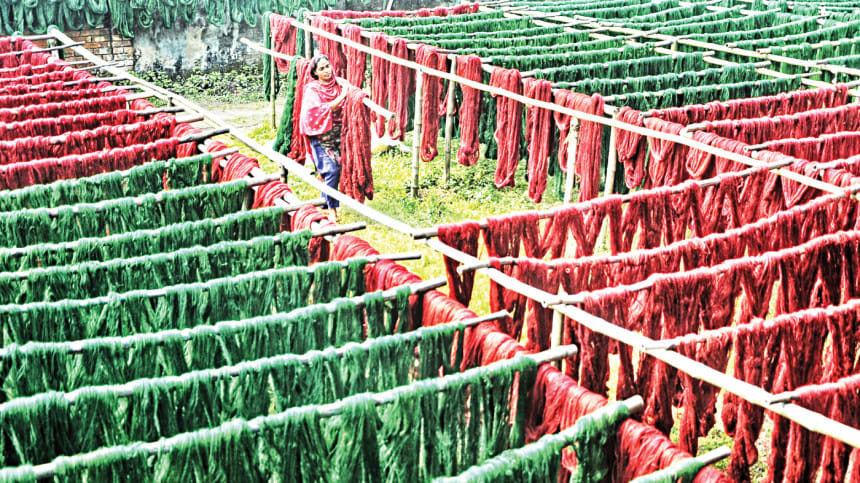Lack of technology, research barring jute diversification

The government's jute diversification plan is a good initiative but its implementation has been slow due to a lack of technology, skilled manpower and relevant research, according to industry insiders.
Jute Diversification Promotion Centre (JDPC) was established in 2002 for a five-year period but its activities actually started on January 1, 2013.
"There are four challenges to diversifying the jute sector in Bangladesh – lack of technology, skilled manpower, fiscal support, and research-based product diversification," said Md Rashedul Karim Munna.
The managing director of Creation Private, a leading manufacturer and exporter of jute products, Munna said jute product manufacturers have failed to update their industry and products and for this reason they struggle to run their businesses.
This also leads to banks losing interest in providing financial support to new entrepreneurs who want to diversify the jute product basked and engage in direct exports. He appreciated the introduction of a 20 per cent cash incentive on the export of jute products and another 7 per cent on jute yarn.
According to him, at least 32 entrepreneurs now manufacture diversified jute products and export those to 39 countries.
The goods include lifestyle, household and agricultural products, home textiles, carpets and shopping bags.
Munna said farmers should be ensured a profit of at least 20 per cent on their jute production alongside availability of local high-yielding seed varieties as 95 per cent of the seeds were currently imported.
The farmers need high yielding jute as the existing varieties are currently not commercially viable for the cultivation of jute on their land, he said.
Munna alleged that although the government created the JDPC, the organisation lacked an adequate budget and has no legal authority to strongly implement any kind of decision.
"For this reason the diversification of jute is slow," he said.
According to the managing director, local jute mills process 60 lakh bales of jute out of the 80 lakh bales produced annually for export-oriented jute products alongside domestic consumption.
Of this amount, only five lakh bales are used locally while the rest 8 lakh bales to 15 lakh bales are exported in its raw form to Germany, South Korea and India.
Munna said the demand for jute products was increasing globally due to rising awareness about the environment.
"We need high-value addition products instead of traditional jute products or export of raw material to bring more economic value from the jute sector," he added.
Rubina Akhter Munni, owner of Design by Munni, a jute product manufacturer and exporter, said she received export orders from the United Arab Emirates, Qatar and Canada on a small scale.
Even if Munni received bulk orders, she would not be able to cater to those due to her limited production capacity.
She also alleged that banks were uninterested in providing support to the jute sector as their previous experience in loan recovery was not satisfactory.
"I have taken part in different fairs at home and abroad and the experience was positive about the rising demand of jute products at home and abroad," Munni noted.
Mohammad Ali, liaison officer of the JDPC, said there were over 800 small-and-medium-scale jute enterprises across the country.
According to him, the JDPC has been providing skills upgradation training as well as designer, artisan and entrepreneurship training for new and existing entrepreneurs to help diversify the country's jute products.
The JDPC also organises fairs and exhibitions at home and abroad to create awareness about the use of environmentally-friendly jute products.
"We also organise buyer-seller meetings, exposure trips, study tours, workshops, seminars, and idea exchanges," Ali said.
The JDPC basically aims to help jute product manufacturers leave their traditional goods for more diversified products.
However, he said there was a big challenge facing jute diversification as the JDPC has no legal foundation or budget for running diversification activities.
Although is huge potential for expanding the market with high-value products, there is a lack of technology and financial support from financial institutions.
Ali went on to say that now jute entrepreneurs manufacture and export 282 types of diversified jute products, including shopping bags, shoulder bags, wine bags, travel bags, school bags, garden bags, golf bags, Christmas decorations and wedding bags.
According to data from the Export Promotion Bureau, the jute sector earned $1161.48 million from the export of jute and jute goods in fiscal 2020-21 whereas it was $882.35 million in the previous fiscal year.
During the July-February period of the current fiscal year, the sector earned $948.33 million from shipments of jute and jute products.
Meanwhile, the government has started handing over jute mills to the private sector as a part of its efforts to modernise the state-run enterprises that deal with the natural fibre.
Bangladesh Jute Mills Corporation (BJMC) shut 25 state-run jute mills to put an end to the heavy losses they had been incurring for years.

 For all latest news, follow The Daily Star's Google News channel.
For all latest news, follow The Daily Star's Google News channel. 



Comments